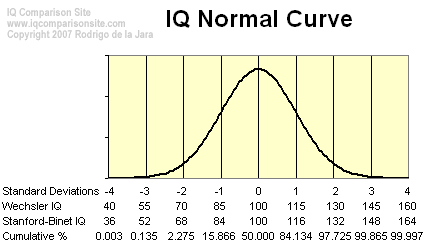

Mental deficiency used to be more finely classified using the following technical terms that later began to be abused by the rest of society (5):
IQ Range Classification
- 50-69 Moron
- 20-49 Imbecile
- below 20 Idiot
High IQ societies ask for certain percentile scores on IQ tests for you to be eligible to join them. Mensa asks for scores at the 98th percentile or higher.
| IQ Range |
Classification |
| 140 and over | Genius or near genius |
| 120-140 | Very superior intelligence |
| 110-120 | Superior intelligence |
| 90-110 | Normal or average intelligence |
| 80-90 | Dullness |
| 70-80 | Borderline deficiency |
| Below 70 | Definite feeble-mindedness |
| Classification | IQ Limits | Percent Included |
| Very Superior | 128 and over | 2.2 |
| Superior | 120-127 | 6.7 |
| Bright Normal | 111-119 | 16.1 |
| Average | 91-110 | 50 |
| Dull Normal | 80-90 | 16.1 |
| Borderline | 66-79 | 6.7 |
| Defective | 65 and below | 2.2 |
Mental deficiency used to be more finely classified using the following technical terms that later began to be abused by the rest of society (5):
| IQ Range | Classification |
| 70-80 | Borderline deficiency |
| 50-69 | Moron |
| 20-49 | Imbecile |
| below 20 | Idiot |
These are now largely obsolete and mental deficiency is now generally called mental retardation. The following is the currently used classification of retardation in the USA (5):
| IQ Range | Classification |
| 50-69 | Mild |
| 35-49 | Moderate |
| 20-34 | Severe |
| below 20 | Profound |
Moreover, “educable mentally retarded” is roughly equivalent to mild mental retardation, and “trainable” mentally retarded is roughly equivalent to moderate (5). The DSM now requires an assessment of a person’s adaptive functioning as an additional criterion for labeling someone retarded. IQ is not enough. Maybe the same sort of thing should be done for labeling somebody a genius.
References
(1) Berk, L.E. (1997). Child Development, 4th ed. Toronto: Allyn and Bacon.
(2) Eysenck, H. (1994). Test Your IQ. Toronto: Penguin Books.
(3) Iman, R.L. (1994). A Data Based Approach to Statistics. Belmont: Duxbury Press.
(4) Nietzel, M.T., Berstein, D.A., Milich R. (1998). Introduction to Clinical Psychology. Upper Saddle River: Prentice Hall.
(5) Reber, A.S. (1995). The Penguin Dictionary of Psychology, 2nd ed. Toronto: Penguin Books.
(6) Wechsler, D. (1944). The Measurement of Adult Intelligence. Baltimore: The Williams & Wilkins Company.
(7) The Merriam-Webster Dictionary Online: http://m-w.com/cgi-bin/dictionary?book=Dictionary&va=intelligence
* Originally, my definition simply said “the ability to learn”, but I found that the expanded dictionary definition is better even if it is not as simple.
Source: For more info see http://www.iqcomparisonsite.com/IQBasics.aspx































Reddit.com – Today I Learned
https://www.reddit.com/r/todayilearned/comments/65j9lu/til_words_idiot_moron_and_imbecile_were_medical/